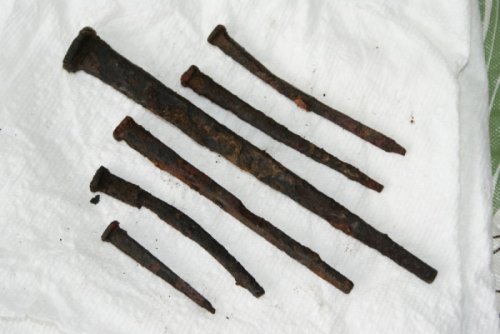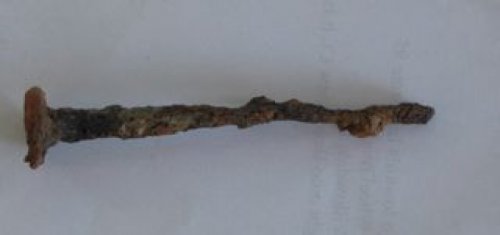diggermeister
Well-Known Member
Hey All, I thought that this was very interesting and helpful on finding/dating the buildings we seek privies behind:
[font="arial, helvetica, sans-serif"]Nails: Clues to a Building's History[/font]
[font="arial, helvetica, sans-serif"]Thomas D. Visser[/font]

Hand-wrought nail, before circa 1800

Type A cut nail, circa 1790-1830

Type B cut nail, circa 1820-1900

Wire nail, circa 1890 to present
Nails provide one of the best clues to help determine the age of historic buildings, especially those constructed during the nineteenth century, when nail-making technology advanced rapidly. Until the last decade of the 1700s and the early 1800s, hand-wrought nails typically fastened the sheathing and roof boards on building frames. These nails were made one by one by a blacksmith or nailor from square iron rod. After heating the rod in a forge, the nailor would hammer all four sides of the softened end to form a point. The pointed nail rod was reheated and cut off. Then the nail maker would insert the hot nail into a hole in a nail header or anvil and form a head with several glancing blows of the hammer. The most common shape was the rosehead; however, broad "butterfly" heads and narrow L-heads also were crafted. L-head nails were popular for finish work, trim boards, and flooring. Between the 1790s and the early 1800s, various machines were invented for making nails from bars of iron. The earliest machines chopped nails off the iron bar like a guillotine, wiggling the bar from side to side with every stroke to produce a tapered shank. These are known as type A cut nails. At first, the heads were often made by hand, but soon machines were developed to pound a head on the end. This type of nail was made until the 1830s. By the 1820s, however, an effective design for a nail making machine was developed: it flipped the iron bar over after each stroke. With the cutter set at an angle, every nail was chopped to a taper. Nails made by this method are known as type B nails.
Cutting the nails leaves a small burr along the edge as the metal is torn apart. By carefully examining the edges for evidence of these burrs, it is possible to distinguish between the earlier type A nails and the later type B nails. Type A nails have burrs on the diagonally opposite edges, while the type B nails have both burrs on the same side. This kind of evidence can be used to establish the approximate period of construction or alteration of a building. Type B cut nails continued to be the most common through most of the greater part of the nineteenth century. With the rapid development of the Bessemer process for producing inexpensive soft steel during the 1880s, however, the popularity of using iron for nail making quickly waned. By 1886, 10 percent of the nails produced in the United States were made of soft steel wire. Within six years, more steel-wire nails were being produced than iron-cut nails. By 1913, 90 percent were wire nails. Cut nails are still made today, however, with the type B method. These are commonly used for fastening hardwood flooring.
[font="arial, helvetica, sans-serif"]Nails: Clues to a Building's History[/font]
[font="arial, helvetica, sans-serif"]Thomas D. Visser[/font]
Hand-wrought nail, before circa 1800
Type A cut nail, circa 1790-1830
Type B cut nail, circa 1820-1900
Wire nail, circa 1890 to present
Nails provide one of the best clues to help determine the age of historic buildings, especially those constructed during the nineteenth century, when nail-making technology advanced rapidly. Until the last decade of the 1700s and the early 1800s, hand-wrought nails typically fastened the sheathing and roof boards on building frames. These nails were made one by one by a blacksmith or nailor from square iron rod. After heating the rod in a forge, the nailor would hammer all four sides of the softened end to form a point. The pointed nail rod was reheated and cut off. Then the nail maker would insert the hot nail into a hole in a nail header or anvil and form a head with several glancing blows of the hammer. The most common shape was the rosehead; however, broad "butterfly" heads and narrow L-heads also were crafted. L-head nails were popular for finish work, trim boards, and flooring. Between the 1790s and the early 1800s, various machines were invented for making nails from bars of iron. The earliest machines chopped nails off the iron bar like a guillotine, wiggling the bar from side to side with every stroke to produce a tapered shank. These are known as type A cut nails. At first, the heads were often made by hand, but soon machines were developed to pound a head on the end. This type of nail was made until the 1830s. By the 1820s, however, an effective design for a nail making machine was developed: it flipped the iron bar over after each stroke. With the cutter set at an angle, every nail was chopped to a taper. Nails made by this method are known as type B nails.
Cutting the nails leaves a small burr along the edge as the metal is torn apart. By carefully examining the edges for evidence of these burrs, it is possible to distinguish between the earlier type A nails and the later type B nails. Type A nails have burrs on the diagonally opposite edges, while the type B nails have both burrs on the same side. This kind of evidence can be used to establish the approximate period of construction or alteration of a building. Type B cut nails continued to be the most common through most of the greater part of the nineteenth century. With the rapid development of the Bessemer process for producing inexpensive soft steel during the 1880s, however, the popularity of using iron for nail making quickly waned. By 1886, 10 percent of the nails produced in the United States were made of soft steel wire. Within six years, more steel-wire nails were being produced than iron-cut nails. By 1913, 90 percent were wire nails. Cut nails are still made today, however, with the type B method. These are commonly used for fastening hardwood flooring.






